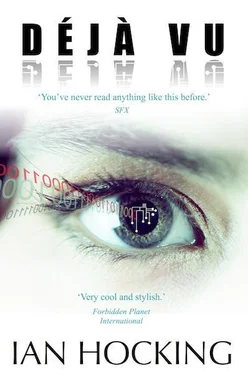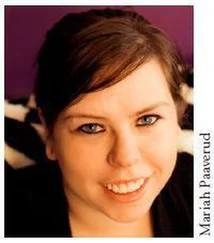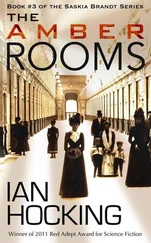She was about tell Besson she had no idea what cryptanalysis meant. Then, the answer came to her. She said, ‘The study of methods for undoing the encryption that has been applied to a signal, in order to discover its true meaning.’
‘Very good.’ His tone was flat and he had difficulty meeting her eyes. She could smell the anxiety on his breath. ‘Yes, very good. So far, we know this. That, sometime in the last forty-eight hours, our suspect initiated a communication using his personal computer as the interface, and telecommunications equipment in his taxi as the transmitter. That the communication was an encapsulated transmission of video and audio. That it passed through the exchanges at ScotIX and MAE-West. That it lasted less than two minutes. That there were two parties involved.’
‘And that we very much want to know its content.’
‘And that.’
‘Milk and sugar, please,’ she said.
Saskia watched him pour four cups of coffee. They were standing next to the long conference table that dominated the room. Garland—a red-haired, thirtyish woman who had travelled up to Scotland with Besson—nodded and took one of the coffees and returned to her station at the head of the table, where she donned smoked glasses and re-entered her workspace. Meanwhile, Besson put milk and sugar into another cup—hesitating, his eyes on Saskia’s knees—and gave it to Saskia. She smiled and stepped away from the coffee machine.
‘Tell me,’ she said, ‘were both ends of the transmission encrypted at source, or were they directed through a third-party server somewhere?’
Besson raised his eyebrows. ‘It’s starting to sound like you should be the consultant, not me.’
‘Let’s say that I don’t remember what I’ve forgotten. Start with the basics.’
Besson sipped his coffee and unzipped his coat. He loosed a sigh of concentration. ‘Basics: encryption being the process of converting publicly readable information into something that can only be understood by the intended recipient. These days, we tend to use something called asymmetric encryption. It’s asymmetric because the key used to encrypt the information is not the same as the key use to decrypt it.‘ Besson made a sound like a purr. ‘It’s…’
‘Complicated?’ she said, sipping.
He grinned and put a hand on the crown of his head, scratching. ‘You remember the Enigma machine?’
‘No.’
‘The Germans used it to encode military transmissions during the Second World War. The cool thing about the Enigma cipher was that it changed itself with each letter of the message. The odds against breaking it were 150 million million million to one. But it was cracked.’
‘How?’
‘It was systematic. It was predictable. With modern computers we could break it easily. But if there is no system, we have a real problem.’ He looked pained. ‘I’ve had a brief look at the data this morning. I’d guess it falls into the unsystematic category. It’s a one-time pad. Unbreakable.’
‘I do not like the sound of that.’
‘Of all the methods of encryption, only one is mathematically impossible to crack, and that’s the one-time pad, or OTP. Even given infinite computing resources, the plaintext could never be recovered from the ciphertext. The OTP uses a key that has the same number of elements as the plaintext. Each plaintext element’s value—be it a letter or a pixel—is transformed by the corresponding random value in the key. As long as each element in the OTP is truly random, there’s no systematic element for a cryptanalyst to sniff out. It’s what we call perfect secrecy. You rarely find OTPs in the wild because they’re unwieldly, but we do use them to teach students the basics of cryptanalysis.’
‘So how does the receiver of the message know how to unravel it?’
‘The sender and the receiver must have identical versions of the key.’
‘And what form might the key take?’
‘It would be a series of random numbers approximately one terabyte in size, in this case—based on my guesses about the format and frame rate of the transmission.’
‘Paul, tell me honestly,’ said Saskia. Her voice was low. ‘Is it possible to discover the contents of Proctor’s communication?’
Jago’s arm reached between them and took one of the coffees. ‘You can forget you heard that name. I mean it.’
‘Oh dear,’ said Besson, looking amused. ‘Somebody point out the irony of spilling the beans to a cryptanalyst.’
Saskia frowned at Jago. ‘Scotty, I have made it clear that I do not agree with your superiors’ policy of restricting information.’
Besson nodded seriously. ‘I like your attitude, Agent Brandt.’
‘It’s Kommissarin ,’ said Jago. He turned to Saskia. ‘All the same, we should keep this on a need-to-know basis.’
‘Did you manage to find a heater?’ asked Besson.
‘That depends. Will you manage to forget the name?’
After a pause, Besson said, ‘Kommissarin Brandt, you were asking about the possibility of cracking an OTP. Well, it has been done. The Signal Security Agency of the US Army managed to crack the OTP of the German Foreign Office in 1944. It turned out the Germans were using a machine whose numbers weren’t completely random. That gave the breakers a foothold. But Proctor’s code? We have no foothold.’
‘Well, looks like you can go back to Cheltenham,’ said Jago, triumphantly. ‘Sorry to have wasted your time.’
‘Scotty,’ said Saskia, ‘the transmission is critical.’
Jago took her elbow and walked her away from Besson.
‘It’s important, maybe. Tell me why it’s critical.’
‘Proctor got this call moments before he walked into the West Lothian Centre with a bomb. Did he receive instructions from the person behind the bombing at that point? Or was it the last message to a loved one from a man about to lose his freedom? In either case, we must discover to whom he was talking. The second party might have been involved in his escape. Perhaps they are waiting for him, helping him.’
‘That “gut instinct” of yours?’
‘I suppose.’
Jago sighed. ‘Alright, hen.’
Saskia walked over to Besson, forced him to look her in the eye, and waited for his smile to answer hers. ‘You say it is unbreakable. Break it for me.’
Jago led Saskia through the foyer of the building, where a crowd of uniformed police had gathered. ‘They’re waiting for news about the service merger,’ said Jago, not stopping. Saskia smiled at a young officer. He winked back in the habit of her boyfriend-who-never-was, Simon. She looked at the linoleum floor and recalled her arrival at the FIB building in flip-flops, irritable with heat and curious about a case. Her secretary. The fridge. Beckmann’s button hole and its curious yellow flower. Now this cold. This mission.
Only variations on a fictional theme, Kommissarin Brandt. Whom do you hunt? Yourself or Proctor?
They passed through the vestibule, down some stone steps in a grassy slope, and stopped beneath a blue lantern. Smart men and women hurried by. Their heads were turned against the cold.
‘Here’ll do,’ Jago said.
‘Do you have a spare cigarette?’
‘I do. Could you not buy your own?’
‘No. It would shatter the illusion that I do not smoke.’
He knocked two examples into his hand. He gave one to her and produced his lighter.
The lighter.
The feeling that returned.
Her eyes closed.
Laughter. The flick of a playing card dealt on a table. The smoke transformed from wisps (lit cigarettes) to plumes (burning furniture, wood, an office, mannequins).
Someone saying, ‘Revenge should have no bounds.’
Читать дальше












